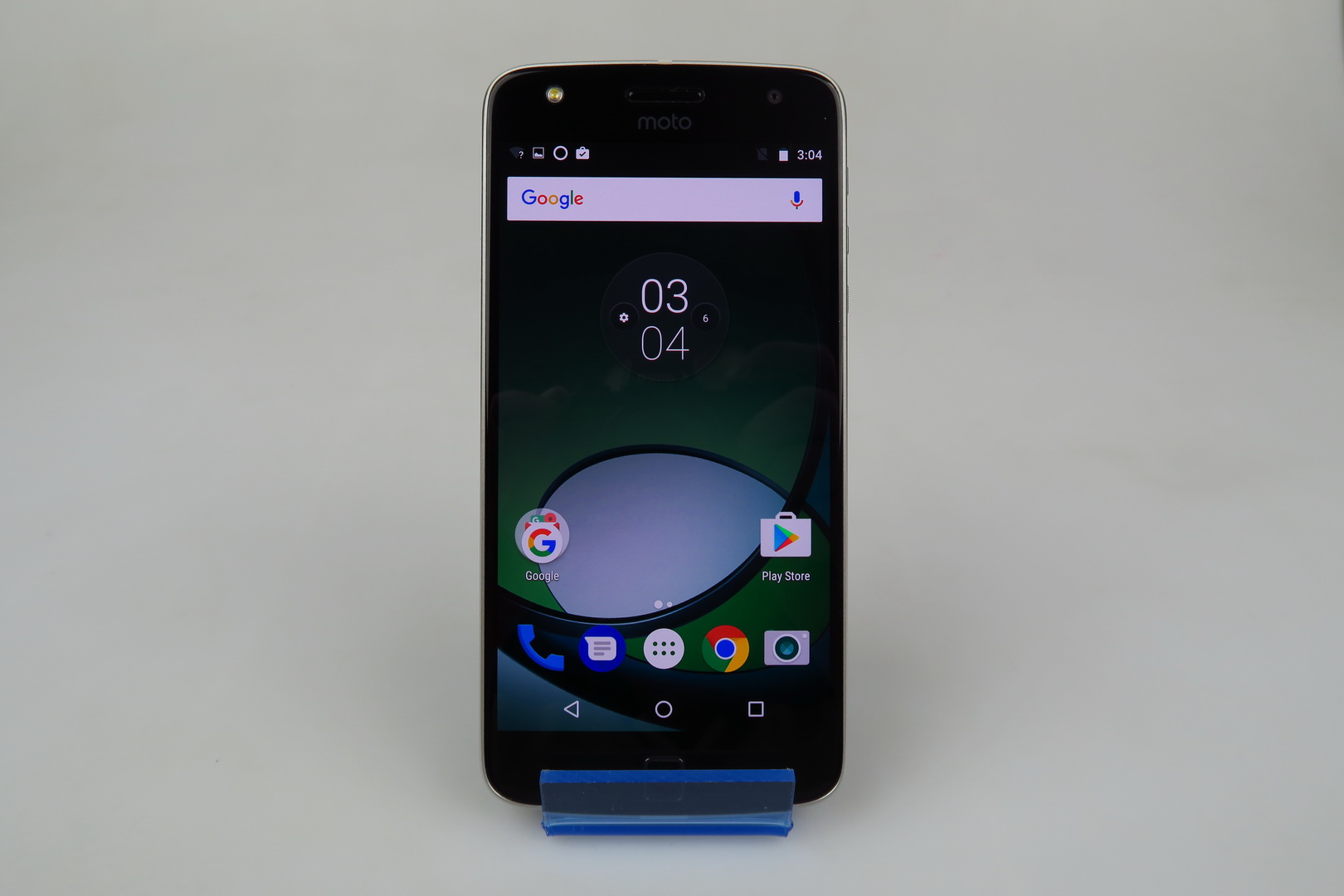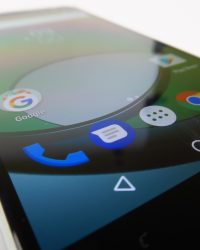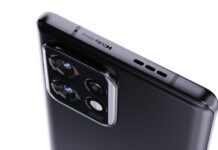It appears we’re playing with quite a few Motorola handsets this year. We’ve played with the Moto Z and its modules, recently the Moto M and Moto G5 also graced us with their presence and the Moto Z Play was also on our test tablet at some point. Now we go back to that model to turn into text the video review you saw. This midrange battery phone is priced at $400.
It’s a lighter Moto Z with some extras and some hardware sacrifices. It’s still a modular phone, that debuted at the end of 2016. It’s available in black, silver, white and gold and it’s the type of upper midrange device that will even take on flagships. The design feels like the device has a bumper case on, just by looking at its bizarre frame.
It’s a sturdy metal frame and the build is quite good in general. We’ve got a glass back here and a pretty shabby looking fingerprint scanner upfront. The handset is 7 mm in thickness and weighs 165 grams. This 5.5 incher is no match to the anorexic Moto Z and its 5.2 mm and 136 gram format, but it’s still quite slim. Moto Z Play does remain quite wide and has some pretty rough edges.
This smartphone is certainly not one to use easily with a single hand and it’s not the comfiest in the world. We’ve got pins at the back used to connect modules and the camera protrudes quite a bit. This phone has a solid build, it’s made of premium materials and the back is a bit prone to scratches and smudges. Luckily, there’s a special grippy lid to cover that.
Another drawback for this phone is the fact it has small buttons on the side and volume and Power one are very easy to mix up. I have to say that the Moto Z was sexier, but the good build remains, in spite of the lack of confort. On to the display, we get a 5.5 inch Super AMOLED Full HD panel, with pretty OK bezel size and Gorilla Glass 4 protection in the mix.
We used Google Photos as the video player of choice and the viewing experience brings on a crisp image, that’s also vivid and bright. Colors are pretty well calibrated, the blacks are deep, view angles are wide and the contrast was good. Pixels have a Pentile Matrix setup and the luxmeter showed a top value of 444 LUX. It’s not uniform though, as some areas of the screen showed lower values.
The max brightness beats the one of the LG G4 and Honor 8, that’s what you have to remember. Still, it placed below the Moto Z and its 491 LUX, or the HTC One M8, or the ZenFone 3 Max for that matter. It remains a solid display, but let’s see if the CPU matches it. It’s a Qualcomm Snapdragon 625, that we’ve also seen on the Huawei Nova and ZenFone 3 models.
There’s 3 GB of RAM to work with here, plus 32 GB of storage and no lag was found, thanks in part to the clean and fluid Android Nougat we ran on the device. All the apps start up fast and things are silky smooth. Games also run in pretty OK manner, like Riptide GP Renegade for examplel that has excellent textures, lighting and frame rate. We also did benchmarks, with Quadrant placing the Moto Z Play above the Huawei Mate 8 and below the Galaxy S6.
In AnTuTu we surpassed the Huawei P9 Lite and Moto M, but scored below the Xperia Z5. 3DMark Ice Storm Unlimited had us above the Huawei Nova and below the OnePlus One, so the GPU isn’t exactly Rambo here. At least it’s clear that this phone is superior to the Moto M and similar in feats to ZenFone 3 and Huawei Nova. Temperature was also quite good, as we barely surpassed 30 degrees Celsius overall.
We hit 29.7 degrees after running GFXBench and 34.3 after running Riptide GP Renegade, so there’s no overheating here. Now let’s address the battery, one of the best we’ve tested in recent history. The 3510 mAh capacity is already a good sign, especially when compared to the Moto Z’s 2600 mAh unit. On paper we are promised 50 hours of mixed usage and this device also brings TurboPower Charge.
Our video playback test in a loop brought us to 18 hours and 5 minutes, which is amazing and placed this phone fifth in our hierarchy. It beats the Galaxy S7 Edge and Allview P8 Energy Pro, but places below the ASUS ZenFone Max. In PCMark we scored an amazing 14 hours and 24 minutes, which is once again great and third placed to only TWO battery phones.
Only the ZenFone Max and Allview P8 Energy beat this phone, while the Allview P9 Energy and Xiaomi Redmi Note 3 are slightly inferior. Charging is done in one hour and 43 minutes fully, which is inferior to the Moto Z’s 1 hour and 15 minutes, but still excellent. 5 minutes of charging brought this battery to 6% and 15 minutes to 21%. 30 minutes meant 39% and one hour was 73%.
The usual Battery Saving features from Nougat are here and if you want even more battery life, there’s the Incipio Power Pack module, with a 2200 mAh capacity and up to 22 hours of extra usage. Overall a superb battery life.
Multimedia must also be tackled here, especially since there are few phones like this one, using the earpiece as the main speaker. There aren’t bundled headphones coming with this phone and we used Play Music to play tunes. Settings include Extreme Bass, Bass Punch, Vocalizer, 5 custom channels and surround effects. With our ears open we caught a loud sound and good bass, no distortion and a pretty good guitar rendered acoustically.
The decibelmeter showed a value of 79.4 dBA at the bottom front side, 74.6 dBA at the bottom back and 81.5 dBA at the top front area. These are achieved with an audio sample, while playing Riptide brought on a value of 88.3 dBA, which may be impressive at the end of 2016, but nowadays there are many phones going over 90 dBA easily. At least it beats the Moto Z, but scores below the Galaxy Note 4.
There’s no FM radio here and if you want superior acoustics, there’s the JBL SoundBoost module, with its own kickstand and over 100 dBA to reach, courtesy of two 3 W speakers. It also includes a 1000 mAh battery. Let’s see what the camera has to offer. Moto Z Play packs a 16 megapixel back shooter, with laser autofocus, PDAF and F/2.0 aperture.
The camera offers 1.3 micron pixels, a dual LED flash, 4K video capture and noi OIS. Moto Z had a 13 MP OIS capable camera, with F/1.8 aperture. The front camera is a 5 MP unit, with F/2.2 aperture, 85 degree wide angel and its own flash. The camera UI is stock and typical for a Nougat device, while the Camera app starts up fast, and the focus speed was OK in my book.
The zoom was finicky sometimes, but the picture taking speed was good. Camera options include timer, HDR, resolution, Panorama, slow motion and Manual with its own sub options: focus, white balance, shutter, ISO and exposure. Moving on to the Gallery of shots taken during the day, we took them in early March, in a day that had some clouds in the sky.
The details were good when it came to zooming in and we also had some pretty OK colors. When we started off some of the shots were blurry, with that huge monument. However, things got pretty good afterwards and we also took some quality selfies, very clear and featuring great colors. Still, in the long run, the amount of blurry shots that appeared was a bit annoying.
It’s very hard to focus at times and some shorts come up darker than they should. The colors are the best attribute here, since they’re expertly calibrated. It’s true that we also achieved some excellent closeups, but things aren’t constant here. The HDR was OK, for that toy boat, especially highlighting the light in a darker area. We also pulled off some nice closeups and a solid focus play.
Details look great even in the distance. The Panorama is very tiny, resolution-wise, at 2792 x 928 pixels, but I actually forgot that on Google’s stock camera software you can actually set up the resolution of the Panorama. I would say that overall the Moto Z Play takes less impressive shots than the Moto Z and can barely fight the ASUS ZenFone 3 and Huawei Nova.
Its best feats are the colors, selfie and details. Indoors we experienced a great texture for the food and closeups, but not at first shot, so we had to re-do them a few times. Half of those food closeups came out blurred and usually a third attempt was good. Low light photo capture brought on good texture, nice lighting and some pretty big street light halos.
The flash makes things look a bit too white, but in general I was happy with the clarity. We caught some very nice street lamps here and I would say that this phone delivers flagship-level clarity. There’s some blur in the distance and some blue hues at times. Closeups are good, the zoom is poor. Interestingly, this is not far from the Moto Z, although that one had a pretty good flash and clarity during the night.
It’s superior to the average midranger of 2016, but inferior to flagships. When it comes to video capture, we shot in MP4 format, in Full HD, at 30 FPS and 17 Mbps. The microphone was good, clarity was solid and we also experienced some refocusing. The zoom was good, though. The stabilization wasn’t exactly top notch, so we lost focus at some point.
Moto Z Play shot a crisp 4K, at 52 Mbps, featuring excellent color rendering and brightness, plus a smooth exposure change. The carousel we filmed ended up with some very weirdly calibrated colors and it seems that this phone can’t handle excess light. The slow motion was OK and overall things felt a bit shaky and inferior to the Moto Z. The video capture was also inferior to the one of the high end Xperias from last year and of course the iPhones.
Low light video featured some strong wind, which bested the microphone and the clips were shaky, plus we had some poor zoom. The clarity and lighting were OK, plus we had some nice colors in the mix, but the focus loss when walking around was annoying. Clarity still remains reasonable throughout the low light video capture. This is no flagship level filming, but the phone can fight the Huawei Nova and ZenFone 3, as well as the Samsung Galaxy A (2016).
We then proceeded to do a web browser test, in this case Chrome. Chrome is fast here, features quite OK benchmarks like Vellamo and Sunspider and input-wise, we’re using a Swype-based keyboard. On the connectivity front things are being kept modern, with USB Type C in the mix, a nano SIM card slot or two (dual SIM setup in some areas) and 3 mics to use.
There’s also Bluetooth 4.1, LTE, WiFi a/b/g/n, GPS and no FM radio whatsoever. At least there’s NFC. Calls are loud and clear, pretty crisp and we’ve also got some good noise cancelling and solid mics. The dialer is stock and the SpeedTest we did revealed a download speed of 90 Mbps in 4G and 45 Mbps upload, while the WiFi was at 117 Mbps download and 25 Mbps in upload. It’s pretty good for a midrange phone.
Time to test the OS, UI and apps aspect. We ran here Android Marshmallow first, then after a week or two we got updated to Nougat, with its wider and cleaner notifications. This is stock Nougat, with a carousel multitasking, split screen multitasking and the usual widgets, wallpapers and settings. The dropdown bit features Quick Settings with two windows and wide notifications.
Settings include Suggestions and a Search bar and we also have options for Moto Privacy and Moto Mods. On the Security side of things, there’s the fingerprint scanner, with a 12 step setup and keeping it pressed locks the device, too. The unlock is fast, by the way. The preinstalled apps list features 28 of them, which is great, meaning there’s no bloatware here.
We’ve got Google Photos, Maps Calendar, Drive, Gmail, the usual setup and the Moto app, with its Gesture, Voice and Glance-style features. We also showed you accessories like the Moto Instashare Projector, a $300 machine, that measures 11 mm in thickness and has a lamp that offers 10.000 hours of usage. This is a 480p DLP projector, with 50 lumens to offer and a 70 inch diagonal image to project, while offering a 16:9 aspect ratio.
There’s also a 1100 mAh battery in the mix. Time to see the verdict for this phone now.
These are the Pros:
- good screen
- solid build
- OK performance
- stellar battery
- solid selfies
- OK night shots
- modern connectivity
- clean OS/ Nougat after the update
The Cons are:
- not very comfy
- should be louder
- some blurred shots
- below the Moto Z in the camera department
- no OIS
- strange colors in videos
Motorola Moto Z Play remains the best midrange phone you can get if the battery is you primary target. It’s a solid selfie machine, has a pretty good camera, good performance and even if some aspects like the acoustics could be better, they’re improved by the modules you can attach to the phone. The clean and fast updated OS is always a big plus.
There are light Nexus/Pixel vibes here and that can only be a good thing. You can get the phone here.






































































































